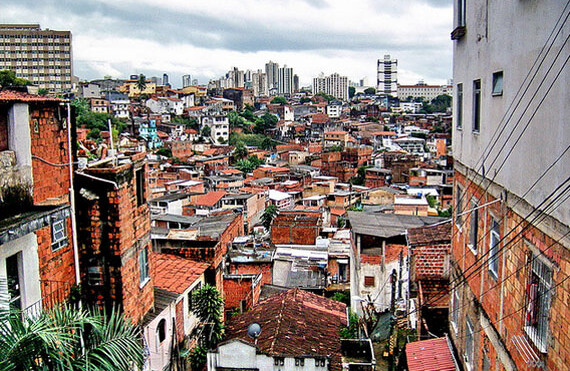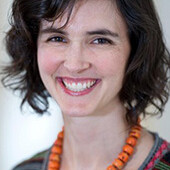In the notoriously dangerous barrio of Petare in Caracas, Venezuela, motorcycles roar through crowds and vendors shout to passersby under an endless canopy of umbrellas and tarps, colorful fruits and vegetables haphazardly piled on the ground. One Sunday morning amid the chaos Alfredo Brillembourg and Hubert Klumpner sat at a table in Petare with sketch paper and a surprising mission—to offer design services to the community for next to nothing, and to change the way urban planners and politicians view slums.
This was the first time Brillembourg and Klumpner had practiced arquitectura buhonera—imitating the informal commerce that so-called buhoneros, or street hawkers, practice all over Caracas. Brillembourg and Klumpner's version culminated in designing a storage shed, an orphanage for a local religious organization, and generally scoping out community needs. The experiment typifies their strategy for building in Latin American slums, what these two founders of the Urban Think Tank refer to as an "urban laboratory."
More than 1 billion people live in slums, and that population is expected to double by 2030 [PDF], according to a United Nations report on "The Challenge of Slums" (2003).
The growth and expansion of slums can be fueled by swift migration from rural to urban settings due to economic displacement or employment opportunities; natural disasters; and the overall inaccessibility of affordable land and housing for the urban poor.
In Venezuela, the barrio of Petare emerged from the construction of a city highway, which took more than a decade to complete. The workers' barracks in the Petare foothills quickly transformed into an ideal space for squatters. Today red-brick, tin-roof shelters, patched with cardboard and soil, cover the steep slopes. Like most slums across the globe, residents suffer from poorly maintained or missing infrastructure, a lack of security, high crime rates, drug trade, amateur construction, and a lack of public spaces.
But barrios and favelas in Latin America can transform into something better than the "formal city." Slums are pedestrian-friendly, produce considerably less trash, and consume less resources. Additionally, they have high levels of social cohesion. "Barrios are no longer the places of transition where people go because they think they will live somewhere else next month or next year," said Klumpner. "If you go in those places, you find the models of how cities could be built. However, assistance is needed."
Brillembourg and Klumpner use their Urban Think Tank to assist barrios in cities like Caracas. The Venezuelan capital, a jumble of concrete apartment buildings and 1970s-era highways, is far from the model they envision for 21st century development. The city is set in a five-pronged valley, following the snaking curves of the Cordillera de la Costa mountain range. The 2800-meter high Avila Mountain separates the city from the Caribbean coast, and at opposite ends of the city stand the immense barrios of 23 de Enero and Petare. Other barrios and informal settlements take over riverbeds as they wind down the mountains into the city center.
More than 90 percent of construction in barrios is done by the people living in the communities, not professional or trained architects. UTT sees this as a positive—residents aren't building beyond their means, only constructing when they have the money or materials. They are also free to build what they want without the limitations of building codes. However, there are dangers in this mode of urban development. The foundations are often set on unstable surfaces, such as landfill or riverbed, and filled with the cheapest concrete available.
Steel rods, or rebar, protrude from the tops of homes, a sign that construction is ongoing. At first, the home may be only one floor, but as families grow or relatives and friends migrate to the city, homes can stretch out and up overnight. "Slowly the hills in Caracas are no longer mountains full of houses, but a house the size of a mountain," said Klumpner.
Over time, the rebar and building foundations stress as buildings grow, and sooner or later, with the slightest earthquake or flood, the structures fail. John Mutter, Director of Graduate Studies in Sustainable Development at Columbia University, says there is not enough focus devoted to safety in settings like Venezuela's barrios. "Earthquakes kill people because buildings collapse," he points out. The tragedy in Haiti illustrates this risk.
The aftermath of natural disasters in rapidly urbanized areas makes most professionals shake their heads and point to poor planning and policy, but Mutter considers this a typical "outsider" perspective, one that runs contrary to the trend in development toward empowering locals. The Urban Think Tank takes a similar tack. Community engagement is the first step in any project they develop, and they consider it vital to the success of their work.
Klumpner and Brillembourg both have strong ties to Venezuela. The two architects met in graduate school at Columbia and decided to apply their education to the "urban South" of Latin America. Brillembourg is Venezuelan and Klumpner, an Austrian, has spent the last ten years living and working in Venezuela.
But to many communities you are still an outsider if you are not living in the barrio, so UTT relies on what they call "social workers" to help bridge that final gap. Despite this symbiosis, it is a labor of love to work in Venezuela, where each day UTT confronts government corruption and bureaucracy, economic volatility and crime.
On a sunny afternoon last November, Klumpner walked down Avenida Lecuna in Caracas with a small group of UTT interns. This stretch of road has projects designed by the Urban Think Tank on 17 different sites surrounding five metro stations as part of a revitalization project. Klumpner was visibly perturbed when he noticed work had restarted on numerous projects that had been sitting idle for over six months. Nobody had called to tell him, which perhaps should not have been so surprising after ten years in Caracas.
Brillembourg and Klumpner understand that building in Latin America is different than projects in New York or Europe. They have seen plans changed without their approval, construction rarely start on schedule, and projects stop and go depending on changes in the government. "If you go to Indonesia, Venezuela, Brazil, there is another pace, another way of how things get done, and we have to adjust to that," said Klumpner.
One of UTT's largest projects, the Metro Cable system in Caracas, demonstrates some of these challenges. The Metro Cable is a cable-car system that connects barrio communities to the subway lines in Caracas. The walk to the top of the hill in Barrio La Cruz is equivalent to a 39-story building, about 1000 steps, and it can take half an hour to get to the formal city. There are also safety concerns when walking up winding, unlit stairs after dark or before dawn.
Klumpner explains that the Urban Think Tank came up with the Metro Cable system like most of their projects—through observation. They held conferences, did a three-year investigation into the idea, and wrote a book. They wanted to create a public transportation system that would serve the barrio community without destroying thousands of homes to build roads.
Due to politics, UTT was largely excluded from the building process once the contracts had been awarded and construction began. In fact, the company was not even invited to the inauguration ceremony in December 2009. Klumpner plays down the snub. "I'm happy to be on the other side of the velvet rope, I blend into the popular masses and just take a ride for fun," he said.
The struggles UTT has faced in projects like the Metro Cable inform another aspect of their approach to building in Latin America: replication. There are a number of videos of their work on YouTube, including projects like the dry toilet. UTT sees this not so much as documentation of past work, but rather as a way of finding people who either want to support the organization or would like to have one of the projects built in their community.
With the political turnover rate in Caracas, UTT has learned to prepare a package where a politician can just sign off, find the money in the budget, and then cut the ribbon. Bureaucrats aren't in office long enough, and usually want to jump over the research and development phase. "We had to learn how to serve it their way, to understand their own interests and political realities," said Klumpner.
When driving to the Caracas airport one passes an entire mountain, towering above the highway, covered in slum housing. Klumpner points out that the sheer size, density, and mass of these barrios are without precedence. The unique make-up of the slums calls for new vocabulary and ways of approaching projects because the traditional tools of urbanism and architecture do not offer solutions.
"Just forget about what you know, just come and look, and learn," said Klumpner. "Much of what you have here, what is generally described as bad, has a lot of virtue. It has a lot to teach us."




